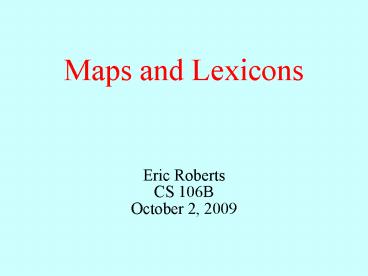Maps and Lexicons - PowerPoint PPT Presentation
1 / 13
Title:
Maps and Lexicons
Description:
... which uses a map to associate three-letter airport codes with their locations. ... The airports.cpp program shows how to read this file into a Map string , where ... – PowerPoint PPT presentation
Number of Views:47
Avg rating:3.0/5.0
Title: Maps and Lexicons
1
Maps and Lexicons
Eric Roberts CS 106B October 2, 2009
2
Methods in the Mapltxgt Class
3
Using Maps in an Application
- Before going on to create new applications of
maps, it seems worth going through the example
from the text, which uses a map to associate
three-letter airport codes with their locations.
- The association list is stored in a text file
that looks like this
ATLAtlanta, GA, USA ORDChicago, IL,
USA LHRLondon, England, United
Kingdom HNDTokyo, Japan LAXLos Angeles, CA,
USA CDGParis, France DFWDallas/Ft Worth, TX,
USA FRAFrankfurt, Germany
.
.
.
- The airports.cpp program shows how to read this
file into a Mapltstringgt, where it can be more
easily used.
4
Methods in the Scanner Class
5
Exercise Maps and Scanners
A map is often called a symbol table when it is
used in the context of a programming language,
because it is precisely the structure you need to
store variables and their values. For example,
if you are working in an application in which you
need to assign floating-point values to variable
names, you could do so using a map declared as
follows
Mapltdoublegt symbolTable
Write a C program that declares such a symbol
table and then reads in command lines from the
user, which must be in one of the following forms
- A simple assignment statement of the form var
number. - A variable alone on a line, which is a request to
display its value. - The command list, which lists all the variables.
- The command quit, which exits from the program.
Download
symtest.cpp
6
Symbol Table Sample Run
SymbolTableTest
gt
pi 3.14159
gt
e 2.71828
gt
x 2.00
gt
pi
3.14159
gt
x
2
gt
list
e 2.71828
x 2
pi 3.14159
gt
x 42
gt
a 1.5
gt
list
e 2.71828
x 42
pi 3.14159
a 1.5
gt
quit
7
Using Iterators
- One of the common operations that clients need to
perform when using a collection is to loop
through the elements of that collection,
executing a piece of code for each one.
- While it is easy to implement iteration for
vectors and grids using for loops, it is not
clear how you would do the same thing for other
kinds of collections, such as maps. - The modern approach to solving this problem is to
use a general tool called an iterator that
delivers the elements of the collection, one at a
time. - Although the text also describes a more
traditional iterator, the easiest approach is to
use foreach, which looks like this
8
Iterator Order
- When you look at the documentation for an
iterator, one of the important things to
determine is whether the collection class
specifies the order in which elements are
generated. The CS106 libraries make the
following guarantees - Iterators for arrays operate in index order, just
as a for loop would. - Iterators for grids operate in row-major order,
which means that the iterator runs through every
element in row 0, then every element in row 1,
and so on. - Iterators for maps make no guarantees whatever
about the order, and in fact cannot do so without
making the iterator considerably less efficient. - Iterators for lexicons always deliver words in
alphabetical order.
9
Methods in the Lexicon Class
10
Why Do Both Lexicon and Map Exist?
- The Lexicon representation is extremely
space-efficient. The data structure used in the
library implementation stores the full English
dictionary in 350,000 bytes, which is shorter
than a text file containing those words. - The underlying representation makes it possible
to implement a containsPrefix method that is
useful in many applications. - The representation ensures that iterators process
a Lexicon in alphabetical order.
11
Exercise Finding S Hooks
- In Scrabble, one of the most important strategic
principles is to conserve your S tiles so that
you can hook longer words (ideally, the
high-scoring seven-letter plays called bingos)
onto existing words.
- Some years ago, I was in a hotel where the shower
taps were prominently labeled with HOT and COLD
- Being a Scrabble player, it happened to occur to
me that each of these words takes an S on either
end, making them ideally flexible for Scrabble
plays. - Write a C program that finds all such words.
Download
findhooks.cpp
12
Exercise Finding Anagrams
- Write a program that reads in a set of letters
and sees whether any anagrams of that set of
letters are themselves words, as illustrated in
the following sample run
FindAnagrams
Enter tiles
ehprsyz
zephyrs
Enter tiles
aeinstr
anestri
nastier
ratines
retains
retinas
retsina
stainer
stearin
- Generating all anagrams of a word is not a simple
task and requires recursion for any simple
solution. Can you think of another way to solve
this problem?
Download
anagrams.cpp
13
The End































